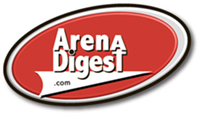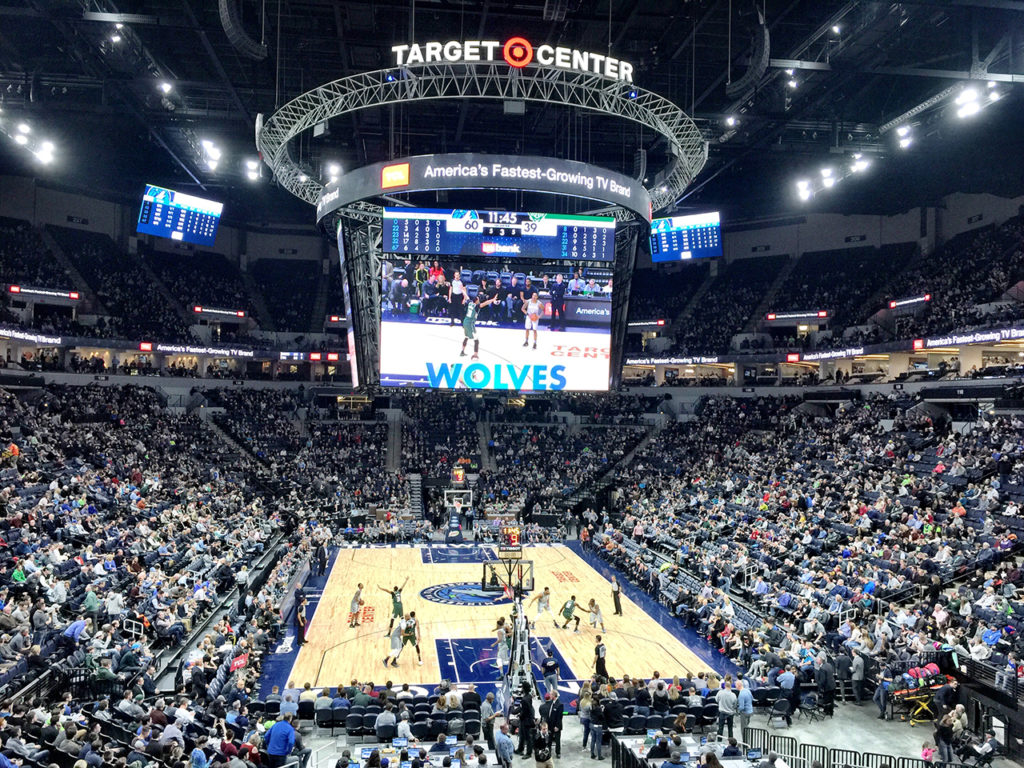Target Center will never be a great NBA facility. It’s too small, it’s landlocked, and it doesn’t provide for the many social spaces found in many new arenas. But with the most recent round of upgrades, it’s become an above-average NBA arena—one providing a sorely needed boost to a franchise on the rise.
There are plenty of issues with Target Center that no amount of renovations can cover. Let’s face it: Target Center was built on the cheap. The original Target Center décor featured lots of concrete blocks and concrete ceilings, and a rather anonymous exterior with limited signage. The design did nothing to fit within the classic Warehouse District exterior and was more a fortress than a piece of a classic area. Views of the outside world were purposely kept away from fans, leaving them with interior concourses and the bowl to provide the game day experience. And it’s a landlocked arena: new development in the form of parking ramps and Target Field limit any chance of an arena expansion.
When the city of Minneapolis was looking to fund the new Minnesota Vikings stadium, money for Target Center renovations was rolled up into a larger proposal. Now, we’ve seen the city gain a lot of notoriety because of U.S. Bank Stadium hosting the most recent Super Bowl. But the changes to Target Center, which ended up costing $145 million (with overages covered the Timberwolves and Minnesota Lynx ownership) may also end up being a good investment for the city as well, as they better integrate the facility into the city fabric while upgrading the game-day experience. The Target Center exterior was softened with new finishes, and a new three-story atrium at the corner of First Avenue and Sixth Street provides a more inviting entrance. The new atrium works both ways: it’s inviting to passersby while giving fans plenty of exposure to the Minneapolis skyline. The main entrance was moved from the First Avenue side of the arena to this new entryway, complete with an expansion. The iconic statue of former Lakers great George Mikan was moved into this entryway as well.
Once you’re inside the arena, the enhanced concourses are more inviting, with plenty of new wood finishes to soften the brutal impact of the concrete walls. (You are in the northwoods, after all.) There still are plenty of concrete blocks on the walls and concrete precasts on the ceilings, but the new finishes are a welcome addition. The concessions have been upgraded, with plenty of local offerings. Concessionaire Levy Resraurants worked with area restaurants to bring local favorites like the Parlour Burger from Borough and Parlour, Sotaritos (sushi burritos) from SotaRol and a very Minnesotan walleye sandwich from Lord Fletcher’s. All in all, there’s an abundance of high-end offerings at concession stands, particularly on the 100 level.
These upgrades, however, pale in comparison to what greets fans in the bowl: a huge four-sided center-hung display with 4,300 square feet of display space. The Target Center renovation was a two-year process, and the new display was actually unveiled in 2016 for the 2016-2017 NBA season. It has LED displays within the larger display for fans sitting near the court. All signage, all the time. Is it perhaps a little out of proportion? Seeing it from near the court, maybe; seeing it from the upper levels of seating, no.
A lot has been said about the modern fan experience looking like something from a video game. But that’s not entirely true. Between the massive display and the upgraded sound system, the Target Center fan experience isn’t like a videogame: it’s directly modeled after a nightclub experience, all flash and sound and excitement and plenty of folks crammed into a small space. That’s where the original design on a small footprint actually helps Target Center.
Other renovations included an overhaul of the arena’s Executive Level into an even more upscale experience, and totally new seating.
These all were necessary upgrades, but it’s not entirely clear how lasting the impact will be. Minneapolis/St. Paul has turned into a rather competitive and crowded arena market. Across the river you have Xcel Energy Center continually improving as well, and the home of the Minnesota Wild is very special place to catch a hockey game or any other high-profile event. And there’s a new competitor in the concert space. The Minneapolis Armory—the final home of the Minneapolis Lakers before they bolted to Los Angeles—has renovated into an 8,200-capacity nightclub. During Super Bowl week, it was crammed with high-end acts, and the plan down the line is to continue to continue offering a high-end experience at a classic venue. And, as we noted at the beginning of this article, Target Center is a landlocked facility. So while we would say that the Timberwolves have a bright future, that future may not play out at Target Center come 20 years from now.
This article originally appeared in the weekly Arena Digest newsletter. Are you a subscriber? Click here to sign up for the free weekly newsletter



